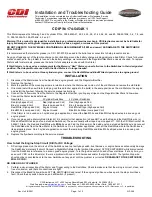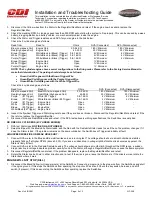
Installation and Troubleshooting Guide
This installation is to be completed by an Authorized Dealer or Professional Service
Technician. For questions regarding installation or warranty, call CDI Tech Support
at 866-423-4832. Do not return to the Dealer or Distributor where the part was purchased.
Contact CDI Electronics Directly for Return Material Authorization.
CDI Electronics, LLC
•
353 James Record Road SW
•
Huntsville, AL 35824 USA
Web Support: www.
•
Tech Support: 1-866-423-4832
•
Order Parts: 1-800-467-3371
All rights reserved. Reproduction or use of content, in any manner, without express written permission by CDI Electronics, LLC., is prohibited.
Rev H
•
4/9/2021 Page - 3 of 3 QF-358
BATTERY CHARGING ISSUES:
1. Regardless if the charging issue is overcharging or not charging at all, the #1 cause of all charging issues is the battery often due to
improper style and
/or charging neglect. #2 is the battery’s connections. #3 is the Regulator/Rectifier. #4 is the Stator.
2. The recommended type of battery for outboards is a single (NOT more than one) 850+ CCA dual purpose or cranking/starting
non-
maintenance-free battery
.
3. Non-maintenance-free batteries (lead-acid flooded cell; has ven
t caps on its top) have heavy, thick plates. They’re ideal for outboards,
where batteries are commonly drained by accessories while fishing, etc. when there is no charge applied to a battery while the battery
is in use. Its heavy plates can withstand constant discharging and charging. These batteries have much more reserve time and are
much more suited for this behavior.
NOTE: Some Maintenance free batteries will have vented caps on top. When in doubt, change the battery to a non-
maintenance free type.
4. Maintenance-free batteries should
NEVER
be used in an Outboard application. A new, fully charged maintenance-free battery may
work fine at first but their life span is dramatically shortened due to the constant charging and discharging. This activity will cause the
cells to become weak, and/or the cells will become dead. When this happens, the battery is unable to accept a full charge, thus putting
the Regulator/Rectifier at extreme risk of failure. Therefore, maintenance-free style batteries commonly cause charging issues shortly
after installation.
5. Check all battery connections, particularly at engine ground. Make sure that all connections are tight and free of corrosion. Do
NOT
use
wing nuts as they tend to loosen over a period of time from vibration. A loose connection
WILL
cause a premature battery and/or
Regulator/Rectifier failure(s).
6. If there is no change, try a single (
NOT
more than one) known good fully charged battery that is 850+ CAA Dual Purpose, or a
cranking/starting battery that is non-maintenance free. Make sure the battery is a lead acid flooded cell battery (has vent caps on its
top).
7. Measure the DVA across the Stator
’s Yellow battery charge wires, while connected to the Regulator/Rectifier. At idle the DVA will
normally between 8-25 DVA. If not, disconnect the Yellow wires from the Regulator/Rectifier and retest. DVA will normally be 17-50
DVA at idle. If the voltage is low, the Stator is possibly faulty. Perform a visual of the Stator for browning and varnish dripping. These
are signs that the Stator has overheated. If the visual inspection shows any of these signs, replace the Stator.
TACHOMETER TESTS
1. Measure the DVA across the Stator
’s Yellow battery charge wires, while connected to the Regulator/Rectifier. At idle the DVA will
normally be between 8-25 DVA. If not, disconnect the Yellow wires from the Regulator/Rectifier and retest. DVA will normally be 17-50
DVA at idle. If the voltage is now within specification, the Regulator/Rectifier is likely defective.
2. Disconnect the Regulator/Rectifier
’s Gray wire. At 800-1,000 RPM, check the DVA on the Grey wire FROM THE
REGULATOR/RECTIFIER measured to engine ground. The reading should be 8 DVA or more. If not, replace the Regulator/Rectifier.
3. If at least 8 DVA, run a jumper wire from the Grey wire out of the harness to one of the Stator
’s Yellow wires.
4. If still no tachometer signal, try a known good tachometer.
5. If still no tachometer signal, replace the Stator.





















